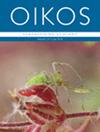扩展格里姆的 CSR 模型,预测植物在不同资源可用性梯度上的人口反应:来自巴塔哥尼亚大草原的证据
IF 3.1
2区 环境科学与生态学
Q2 ECOLOGY
引用次数: 0
摘要
有性生殖、生长和存活是植物种群生存的关键人口策略。在此,我们提出了一个概念模型,根据物种的生态策略和生物地理单元内环境条件的异质性来预测物种的人口响应,并将其应用于巴塔哥尼亚大草原 5˚ 纬度梯度的案例研究。我们的目标还包括区分遗传和环境对人口反应的影响。我们对巴塔哥尼亚大草原西植物地理区六个地方种群中的两个物种进行了原地和普通花园实验。这两个物种在关键生态特征上存在差异,因此符合格里姆的植物进化策略模型:一个是竞争性物种,另一个是抗压性物种。我们计算了种群增长率(λ),并进行了弹性分析,以比较不同物种之间以及沿 600 公里纬度梯度分布、年平均降水量(MAP)不同的当地种群之间每种人口策略对种群适宜性的贡献。我们强调了四个结果。首先,随着年平均降水量的增加,竞争性物种从有性生殖转变为生长。其次,耐压物种在平均年降水量梯度上依赖生长和生存。第三,资源可用性的年际变化调节了两种策略的人口响应。第四,根据对原地实验和普通花园实验的比较,我们认为人口响应是由基因驱动的。我们的研究表明,在不同的环境梯度中,生态策略可以大致预测人口响应。我们的研究表明,不仅物种之间存在差异,而且物种内部的局部种群之间也存在基因驱动的差异。将植物水平的反应放大到种群水平的动态,可以对当前和未来的生物地理物种组织有一个基于过程的理解。此外,保护和恢复工作应遵循作为种群生存基础的人口策略。本文章由计算机程序翻译,如有差异,请以英文原文为准。
Extending Grime's CSR model to predict plant demographic responses across resource availability gradients: evidence from the patagonian steppes
Sexual reproduction, growth, and survival are crucial demographic strategies for plant population viability. Here, we propose a conceptual model predicting demographic responses of species based on their ecological strategy and the heterogeneity of environmental conditions within a biogeographical unit and then applied it to a case study from a 5˚ latitudinal gradient in the Patagonian steppes. We also aim to disentangle genetic from environmental effects on demographic responses. We performed in situ and common garden experiments with two species from six local populations of the Occidental Phytogeographical District of the Patagonian steppes. Species differ in key ecological traits, and thus fit into Grime's model for evolutionary strategies in plants: one as competitive species and the other as stress‐tolerant species. We calculated population growth rate (λ) and performed elasticity analyses to compare the contribution of each demographic strategy to population fitness between species and among local populations distributed along 600 km latitudinal gradient with differences in mean annual precipitation (MAP). We highlight four results. First, the competitive species change from sexual reproduction to growth as MAP increases. Second, the stress‐tolerant species relied on growth and survival along the MAP gradient. Third, interannual variation in resource availability modulated demographic responses for both strategies. Fourth, based on the comparison of the in situ and common garden experiments, we submit that demographic responses were genetically driven. Our study shows that demographic responses can be roughly predicted by the ecological strategy across environmental gradients. We show that differences arise not only between species, but also were genetically driven differences within species among local populations. Scaling up plant‐level responses to population‐level dynamics allows for a process‐based understanding of current and future biogeographical species organization. Furthermore, conservation and restoration efforts should be guided by demographic strategies underlying population viability.
求助全文
通过发布文献求助,成功后即可免费获取论文全文。
去求助
来源期刊

Oikos
环境科学-生态学
CiteScore
6.20
自引率
5.90%
发文量
152
审稿时长
6-12 weeks
期刊介绍:
Oikos publishes original and innovative research on all aspects of ecology, defined as organism-environment interactions at various spatiotemporal scales, so including macroecology and evolutionary ecology. Emphasis is on theoretical and empirical work aimed at generalization and synthesis across taxa, systems and ecological disciplines. Papers can contribute to new developments in ecology by reporting novel theory or critical empirical results, and "synthesis" can include developing new theory, tests of general hypotheses, or bringing together established or emerging areas of ecology. Confirming or extending the established literature, by for example showing results that are novel for a new taxon, or purely applied research, is given low priority.
 求助内容:
求助内容: 应助结果提醒方式:
应助结果提醒方式:


